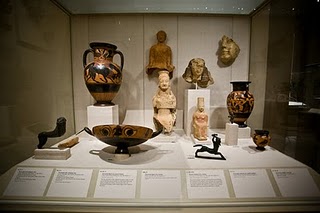To explain the decorative excesses of Champagne sculpture, reference has often been made to the influence of the Netherlands, of which Nicolas Halins, established in Troyes from 1494 to 1544, could have been one of the transmitters, but not, as has wrongly been said, the only one. Indeed, the penetration of northern formulas through imported objects or the influx of foreign artists, forms part of a general movement, which in sculpture partially included
Tuesday, March 15, 2011
CHAMPAGNE AND PICARDY
In a style familiar and fashionable by turns, the Champagne workshops produced, around 1500, long anonymous processions of devotional images in stone or polychrome wood, in marble or alabaster: Virgin and Child or male and female saints, at whose feet was often carved the donor’s diminutive kneeling figure. The wholly Gothic plastic density of these statues, their poised gestures, their gentle, delicate and regular faces, are accompanied by many anecdotal details and coquetries of dress embroidered braid, small hanging chains, studded belts, pleated and knotted ribbons—even more abundant than in other regions of France. Concurrently the dolorous themes of the Passion are treated in a serious and reserved tone, stripped of pomp or pathoa, in a large and famous collection of works gathered around the St Martha of the church of the Madeleine at Troyes
To explain the decorative excesses of Champagne sculpture, reference has often been made to the influence of the Netherlands, of which Nicolas Halins, established in Troyes from 1494 to 1544, could have been one of the transmitters, but not, as has wrongly been said, the only one. Indeed, the penetration of northern formulas through imported objects or the influx of foreign artists, forms part of a general movement, which in sculpture partially includedChampagne as well as Picardy , Artois and Normandy Antwerp Normandy
To explain the decorative excesses of Champagne sculpture, reference has often been made to the influence of the Netherlands, of which Nicolas Halins, established in Troyes from 1494 to 1544, could have been one of the transmitters, but not, as has wrongly been said, the only one. Indeed, the penetration of northern formulas through imported objects or the influx of foreign artists, forms part of a general movement, which in sculpture partially included
Subscribe to:
Post Comments (Atom)




No comments:
Post a Comment